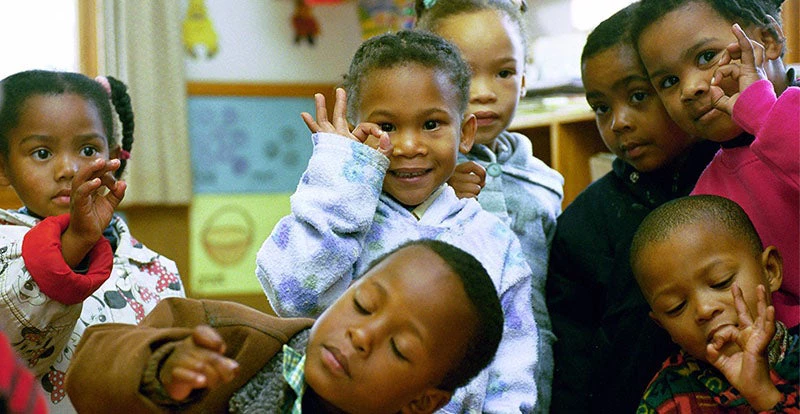 Farmers' children at daycare. South Africa.
Farmers' children at daycare. South Africa.
Ensuring that all children receive high quality early learning experiences is a crucial step towards ending Learning Poverty. Policymakers, development partners, parents, and other stakeholders need information on children’s learning outcomes, and countries need to generate data in a way that can foster improvements in programs and policies. This need existed prior to the COVID-19 pandemic, but it is even more urgent now that millions of children are out of school, with the youngest children in particular risk of being left out of remote learning efforts.
There have been various global initiatives to promote measurement and monitoring of children’s development in the preschool years (here defined as ages 4 to 6). However, there is no single international monitoring program at the preschool level in which the same items are administered to representative populations of preschool-aged children around the world at a regular frequency (as there are for learning outcomes in upper primary and secondary school grades). Many tools have been developed to measure early childhood outcomes, but it has been difficult to get an accurate and comprehensive view of how child development varies across the globe because the tools used do not always capture the same developmental domains in the same way. For instance, while tools measuring early childhood outcomes in the preschool years tend to target similar developmental domains, the items used often differ from tool to tool, which limits the capacity to compare data and results across countries and different measurement initiatives.
In order to link scores across tools, a common set of items needs to be embedded to measure the same constructs in each tool. For this to be feasible across a wide range of early childhood measurement initiatives, the common set of items needs to have three key features. First, the set needs to be short enough so that adding it to an existing tool does not make the overall measurement exercise excessively burdensome. Second, the common set of items needs to demonstrate acceptable psychometric properties across as wide a range of contexts as possible in order to ensure the quality and relevance of the data collected in each context. Third, the core set of items needs to be openly accessible to a wide range of stakeholders.
Further, a core set of items will allow for increased efficiencies and synergies and improved quality across data collection efforts, for example through the provision of common guidance around data collection, data management, and data analysis, thus helping to ensure that stakeholders are collecting comparable and relevant data with high-value information on child development in the preschool years.
The potential of a core set of items to support the scaling up of global efforts to measure early childhood outcomes was the motivation behind the work presented in a recently published paper (open access) entitled, “Measuring early childhood development among 4-6 year olds: The identification of psychometrically robust items across contexts”. Data from twelve low- and middle-income countries from around the world were gathered, harmonized, and analyzed in order to identify items that present robust psychometric properties across contexts. The analyses targeted the 4-6 age range (48-83 months), in order to complement existing global measurement initiatives to identify sets of items that demonstrate adequate psychometric properties across contexts for children aged 24-59 months in the context of the SDG 4.2.1 and for children aged 0-36 months - the Early Childhood Development Index (ECDI 2030) and the Global Scale for Early Development (GSED), respectively.
The analyses revealed 20 caregiver report items and 84 child direct assessment items (grouped into 16 tasks) that show strong psychometric properties across countries and that cover the domains of early literacy, early numeracy, executive functioning, and social-emotional competencies. Thus, these items demonstrate the characteristics needed to serve as a core set of items that can be used to link scores across tools and contexts. In order to support the implementation of this core set of items, they will be made freely available to policymakers and other stakeholders, along with complementary guidance materials (currently under development) on training, implementation, data analysis, and reporting.
It is important to emphasize that the core set of items identified in the paper do not capture all relevant data for all early childhood measurement purposes. For example, while these items might serve some monitoring purposes, they would likely need to be supplemented with additional items in order to provide a more nuanced and complete set of data on early childhood development outcomes for purposes such as impact evaluations or to more specifically respond to the needs of local contexts. One way of addressing this limitation would be to embed the core set of items into other commonly used or country-specific measures of early childhood development. We will continue to collaborate with partner organizations, researchers, and stakeholders to strengthen the evidence for the use of the core items in these ways and to ensure alignment with other early childhood measurement initiatives.
We hope this core set of items, along with the guidance materials for implementation, will serve as global public goods so that they can (i) present a starting point for linking across different early childhood measurement tools; (ii) increase quality across early childhood measurement initiatives; and (iii) facilitate the scale up of early childhood measurement globally. When supplemented with items that capture local contexts and measurement needs, this core set of items can help to advance understanding of universal and context-specific factors that underlie child development and thus help policymakers make decisions that ensure children receive the quality early childhood care and education they need in order to reach their full potential.
To learn more about the process of identifying the core set of items, please see the recently published article that presents this work. If you are interested in accessing the core set of items and guidance materials mentioned in this blog post, please contact Adelle Pushparatnam and Diego Luna Bazaldua. See also this blog post to learn how we are supporting stakeholders to measure the impacts of the COVID-19 pandemic on young children and their families.



Join the Conversation